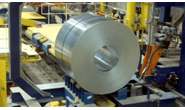Trade Cases

European Commission Institutes Safeguard Measures on Steel Imports
Written by Sandy Williams
July 19, 2018
The European Commission has announced it will impose provisional steel quotas to prevent steel imports from being diverted from the U.S. to Europe.
The safeguard measures will go into effect July 19 and will remain in place for a maximum of 200 days. The provisional measures will affect 23 steel product categories and take the form of a Tariff Rate Quota. A 25 percent tariff will be placed only after imports exceed the three-year average and will be allocated on a first-come first-served basis. The measures will cover all countries except those with limited imports to the EU and the European Economic Area countries of Norway, Iceland and Liechtenstein.
Commissioner for Trade Cecilia Malmström said: “The U.S. tariffs on steel products are causing trade diversion, which may result in serious harm to EU steelmakers and workers in this industry. We are left with no other choice than to introduce provisional safeguard measures to protect our domestic industry against a surge of imports. These measures nevertheless ensure that the EU market remains open and will maintain traditional trade flows. I am convinced that they strike the right balance between the interest of EU producers and users of steel, like the automotive industry and the construction sector, who rely on imports. We will continue to monitor steel imports in order to take a final decision by early next year, at the latest.”
Comments will be taken into consideration toward a determination of final definitive measures. The European Commission hopes to conclude that investigation by early 2019.
Twelve steel product categories covered by the provisional safeguard measures are currently subject to anti-dumping and countervailing duties (e.g., China, Russia, Ukraine). In order to avoid the imposition of “double remedies,” whenever the tariff quota is exceeded, the Commission will consider the suspension or the reduction of the level of these duties to ensure that the combined effect of these measures does not exceed the highest level of the safeguard or anti-dumping/anti-subsidy duties in place.
The safeguards are part of a three-pronged response to U.S. tariffs on steel an aluminum that include “rebalancing measures” imposed on June 20 and legal action filed with the World Trade Organization on June 1.
The measure was welcomed by the European Steel Association (Eurofer) and the European Steel Tube Association, but was condemned by European automakers who fear the tariffs will push elevated steel prices even higher.

Sandy Williams
Read more from Sandy WilliamsLatest in Trade Cases

CRU: ‘Liberation Day’ brings sweeping US tariffs
For trading partners, the tariffs will reduce demand for exports and depress growth. Over the coming days, trade partners will almost certainly announce retaliation, which will hit US exports.

Leibowitz: The blowback from Trump’s ‘Liberation Day’ tariffs has only just begun
Tariffs are taxes that the government collects. Funds are disbursed by acts of Congress. If domestic companies, including manufacturers, are to benefit from “protective” tariffs, they must raise their prices as well. Maybe not by the entire amount of the tariffs, but by some. Inflation will come.

Supply chains, end-users brace for impact from tariffs
Supply chains are working through what the tariffs mean for them

Commerce releases prelim anti-dumping duties in sweeping trade case targeting CORE imports
The US Commerce Department on Friday released preliminary anti-dumping margins in a trade case targeted imports of coated flat-rolled steel from 10 countries. Certain countries and mills were hammered while others were largely spared. Brazilian steelmaker CSN, for example, received a preliminary rate of 137.76%. Some Turkish mills – including Boreclik and ArcelorMittal Celik Ticaret – received no dumping margin at all.

CRU: Trump’s sweeping tariffs could derail the US met coal industry
Latest tariffs could lead to US metallurgical coal exporters (many already high-cost swing producers) being priced out of the market.
